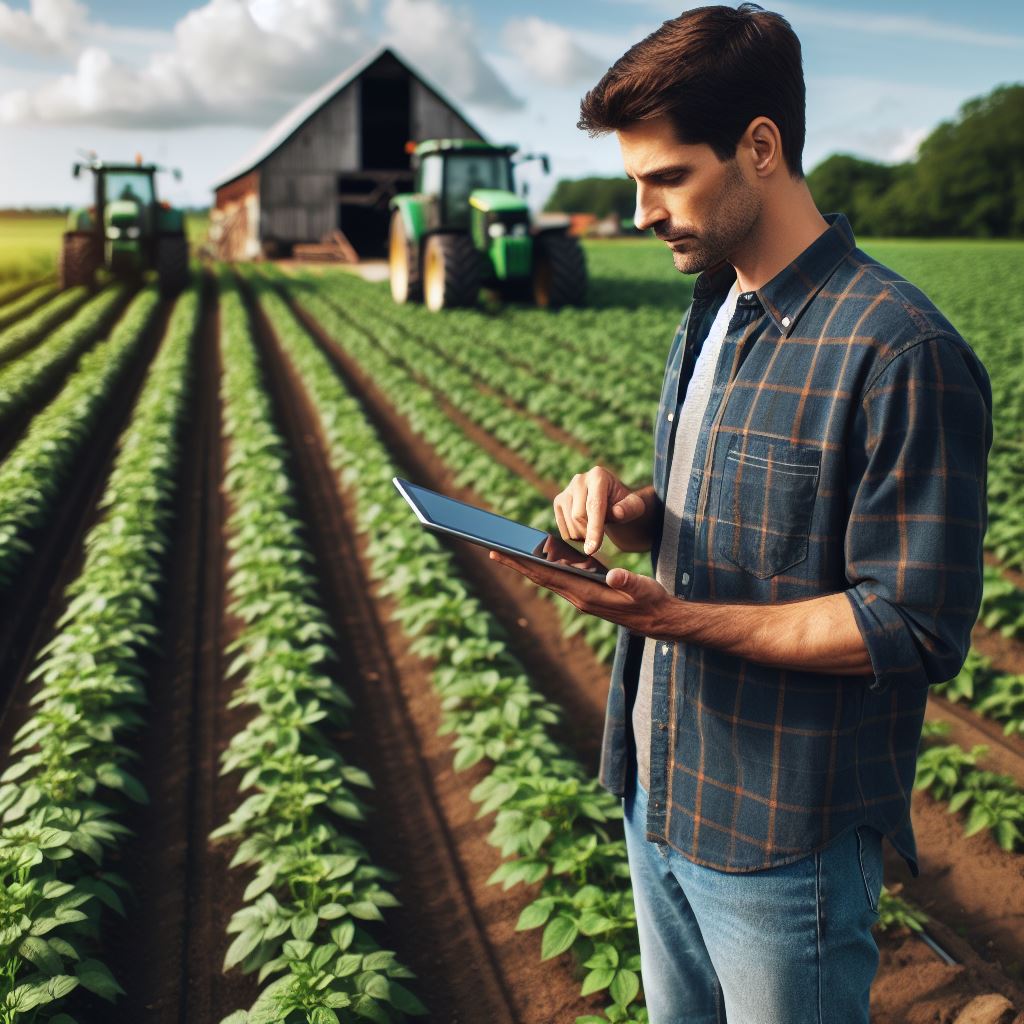Introduction
Integrated Pest Management (IPM) is a crucial approach in agriculture that focuses on crop protection and optimum production.
IPM involves the use of multiple strategies to control pests effectively, while minimizing the negative impacts on the environment and human health.
Definition of IPM (Integrated Pest Management)
IPM is an ecosystem-based approach to pest management that integrates various practices, including biological control, cultural techniques, and the judicious use of pesticides.
It aims to reduce pest populations while maintaining agricultural productivity and sustainability.
Importance of maximizing crop production in farming
Maximizing crop production is of paramount importance in farming for several reasons. Firstly, it ensures a steady food supply to meet the growing demands of an increasing global population.
Additionally, higher crop yields contribute to economic growth, as farmers can sell more produce and generate higher incomes.
Moreover, by maximizing crop production, farmers can minimize the risk of food shortages and price volatility. This is particularly crucial in regions where food security is a concern.
Sustainable agricultural practices, such as IPM, play a vital role in achieving higher crop productivity while safeguarding the environment.
Furthermore, maximizing crop production allows farmers to optimize the use of water, land, and other resources.
By adopting IPM techniques, farmers can minimize the use of chemical pesticides, reducing environmental contamination and promoting the long-term health of ecosystems.
In essence, IPM is an integral part of maximizing crop production in farming. It provides a holistic approach to pest management, balancing the need for crop protection with environmental sustainability.
By implementing IPM strategies, farmers can achieve higher yields, economic stability, and a more secure food supply for the future.
Understanding IPM
Integrated Pest Management (IPM) is a holistic approach to managing pests in agriculture.
Explanation of IPM principles
- IPM focuses on preventing and controlling pests using multiple strategies.
- It aims to minimize the use of chemical pesticides and protect the environment.
- IPM emphasizes the importance of monitoring pests and establishing action thresholds.
- Pest identification is crucial for determining the most effective control measures.
- The use of biological controls, such as beneficial insects, is an essential IPM practice.
- Cultural practices, such as crop rotation and sanitation, play a significant role in IPM.
Components of IPM (monitoring, identification, prevention, control)
- Monitoring: Regularly inspecting crops to assess pest populations and damage levels.
- Identification: Accurately identifying pests and understanding their life cycles and habits.
- Prevention: Implementing preventive measures to reduce pest infestations, such as using pest-resistant varieties.
- Control: Applying appropriate pest control measures when pest populations exceed action thresholds.
Benefits of adopting IPM practices
- Reduced reliance on chemical pesticides, leading to less environmental contamination.
- Cost-effectiveness due to targeted pest management, minimizing unnecessary pesticide use.
- Preservation of beneficial insects, which help control pests naturally.
- Long-term sustainability of crop production by maintaining ecological balance and biodiversity.
- Protection of human health through decreased exposure to harmful pesticides.
- Enhanced crop quality and yield by effectively managing pests and preventing crop damage.
- Compliance with regulations and consumer demands for eco-friendly and sustainable farming practices.
Essentially, IPM offers a comprehensive approach to maximizing crop production while minimizing the negative impacts of pests and chemical pesticides.
By understanding the principles of IPM and implementing its various components like monitoring, identification, prevention, and control, farmers can effectively manage pests and achieve sustainable agriculture.
Transform Your Agribusiness
Unlock your farm's potential with expert advice tailored to your needs. Get actionable steps that drive real results.
Get StartedAdopting IPM practices brings numerous benefits, including reduced environmental contamination, cost-effectiveness, preservation of beneficial insects, and improved crop quality and yield.
With its focus on ecological balance and human health, IPM is a vital tool for the modern agricultural industry.
Monitoring and Identification
Regular field inspections
Regular field inspections are crucial for monitoring and identifying pests in Integrated Pest Management (IPM), aimed at optimizing crop production.
These inspections involve systematic assessments of crop health, pest populations, and environmental factors.
By closely monitoring fields, farmers can detect pest outbreaks early, enabling timely interventions such as cultural, biological, or chemical controls.
Utilizing IPM techniques minimizes reliance on pesticides, promotes ecological balance, and sustains long-term crop health.
Through proactive monitoring and identification, IPM strategies effectively manage pests while maximizing yields, ensuring sustainable agricultural practices and safeguarding crop production.
Identifying potential pests and diseases
Monitoring and identification are crucial steps in Integrated Pest Management (IPM) to enhance crop production. Regular scouting of fields enables early detection of potential pests and diseases.
Techniques include visual inspection, pheromone traps, and using technology like drones and sensors for precision monitoring.
Identifying pests and diseases accurately allows for targeted interventions, reducing reliance on broad-spectrum pesticides.
Employing trained personnel and utilizing diagnostic tools aid in precise identification.
Timely actions such as biological control, cultural practices, and selective pesticide use mitigate pest pressure while minimizing environmental impact, ensuring sustainable crop yields within IPM frameworks.
Assessing pest and disease levels
Monitoring and identification in Integrated Pest Management (IPM) involves regular surveillance to assess pest and disease levels, crucial for maximizing crop production sustainably.
Techniques like trap crops, pheromone traps, and visual inspections aid in pest detection.
Monitoring tools such as remote sensing and digital image analysis offer advanced means of assessing crop health.
Early detection allows for timely intervention, reducing the need for chemical pesticides.
Utilizing biological controls and cultural practices tailored to specific pest and disease dynamics ensures effective management.
IPM emphasizes a holistic approach, integrating multiple strategies for sustainable agriculture while minimizing environmental impact and preserving natural resources.
Utilizing technology for monitoring
Monitoring and Identification in Integrated Pest Management (IPM) involves employing technological tools to maximize crop production while minimizing pest damage.
These technologies include remote sensing drones equipped with cameras to detect early signs of pest infestations, automated traps that capture and identify pests, and sensor networks for real-time data collection on environmental conditions.
Data analytics and machine learning algorithms analyze this information, providing farmers with insights for timely intervention strategies, such as targeted pesticide applications or biological control measures.
By integrating technology into IPM, farmers can optimize crop yields while reducing reliance on chemical pesticides, fostering sustainable agriculture practices.
Prevention Methods
In order to maximize crop production, it is essential to implement effective prevention methods. Such methods include:
Crop rotation and diversification
Crop rotation and diversification serve as preventive measures against pests and diseases.
Showcase Your Farming Business
Publish your professional farming services profile on our blog for a one-time fee of $200 and reach a dedicated audience of farmers and agribusiness owners.
Publish Your ProfileBy rotating crops and diversifying the plantings, farmers can disrupt the life cycles of specific pests, making it harder for them to establish and survive.
Moreover, diverse crops create a more complex and balanced ecosystem, keeping pest populations in check naturally.
Proper soil management
Proper soil management plays a fundamental role in pest prevention. Maintaining healthy soil with adequate organic matter content and appropriate nutrient levels promotes strong plant growth.
Healthy plants are more resistant to pests and diseases, as they can better defend themselves against attacks.
Providing optimal growing conditions
Providing optimal growing conditions ensures that crops reach their maximum production potential. Proper irrigation practices prevent water stress, which weakens plants and makes them more susceptible to pests and diseases.
Adequate sunlight exposure enhances plant growth, while supplying the right nutrients optimizes nutrient uptake, strengthening plants’ immune systems.
Using resistant crop varieties
Using resistant crop varieties contributes significantly to pest prevention. Plant breeders have developed crops with genetic traits that make them naturally resistant to specific pests and diseases.
By planting these varieties, farmers can significantly reduce the need for chemical pesticides, thus minimizing the impact on the environment and human health.
In all, preventing pests and diseases is crucial for maximizing crop production.
Implementing prevention methods such as crop rotation and diversification, proper soil management, providing optimal growing conditions, and using resistant crop varieties is essential for sustainable agriculture.
By adopting these approaches, farmers can minimize crop losses, enhance their yields, and promote overall farm productivity while ensuring environmental sustainability.
Control Measures
In order to maximize crop production, Integrated Pest Management (IPM) employs various control measures
Integrated Pest Management (IPM) combines these control measures to achieve optimal crop production. Let’s dive deeper into each control measure:
Biological Control
In IPM, beneficial insects and natural predators act as allies against harmful pests. They are nature’s own pest control agents.
For example, ladybugs are known to feast on aphids, protecting crops from destruction.
This approach involves enhancing the population of beneficial insects, which in turn reduces the need for chemical pesticides.
It is a sustainable and eco-friendly method as it mimics nature’s own checks and balances system.
Cultural Control
Cultural control measures focus on creating a hostile environment for pests and preventing their entry into the crop fields.
Crop sanitation practices, such as removing plant debris and cultivating pest-resistant varieties, help reduce the chances of infestation.
Weed management is another critical aspect of cultural control. Pests often thrive in weed-infested fields. Regular weeding is essential to minimize the potential habitats for pests and disrupt their life cycles.
Physical Control
Physical control measures involve physical barriers and traps to hinder pests’ access to crops and capture them. These techniques serve as proactive and preventive steps to minimize pest populations.
Barriers can be physical structures that create a physical separation between crops and pests. For example, installing netting around fruit trees prevents birds from feasting on the harvest.
Traps are designed to attract and capture pests. This is a targeted method to control specific pests without harming beneficial insects or other organisms. For instance, pheromone traps are used to lure and capture fruit flies, protecting the fruit yield.
Chemical Control
Chemical control is considered a last resort in IPM, as it may have negative effects on the environment and human health. However, if non-chemical methods are insufficient, judicious use of pesticides becomes necessary to protect crops.
Safety precautions are crucial when using chemical pesticides to minimize risks. Selective and targeted applications are preferred to ensure minimal harm to beneficial organisms and the surrounding ecosystem.
IPM encourages the use of chemicals as a last line of defense, with a focus on choosing less toxic pesticides and application methods that minimize environmental impact.
In fact, IPM combines biological, cultural, physical, and chemical control measures to maximize crop production while minimizing the adverse effects of pests. This holistic approach ensures sustainable agriculture and maintains the delicate balance of ecosystems for future generations.
Read: Preventing Soil Erosion Naturally
Tools and Techniques for IPM Implementation
Integrated pest management (IPM) is a holistic approach to maximizing crop production while minimizing the use of harmful pesticides.
In order to successfully implement IPM strategies, farmers and growers rely on a variety of tools and techniques. Here are some of the key ones:
- Integrated pest management plans: Developing a comprehensive IPM plan is crucial. This plan includes a thorough understanding of the pests and diseases that affect crops, as well as the biological, cultural, and chemical control methods that can be used to manage them effectively.
- Pest and disease scouting records: Regular monitoring of crops is essential for early detection of pest and disease outbreaks. Farmers keep detailed records of the presence and severity of pests and diseases, which helps them identify patterns and make informed decisions about control measures.
- Decision-support systems: Technology plays a vital role in IPM implementation. Decision-support systems, such as computer models and mobile applications, provide real-time data on weather conditions, pest populations, and disease forecasts. These tools assist farmers in making timely and accurate decisions about pest and disease control.
- Engaging with agricultural extension services: Farmers often seek guidance from agricultural extension services, which are government agencies or non-profit organizations that provide information and assistance to farmers.
Extension agents offer expertise in IPM strategies, helping farmers stay up to date with the latest research and best practices. - Crop rotation: Crop rotation is a widely-used IPM technique that involves alternating the type of crops grown in a particular field from season to season.
By rotating crops, farmers disrupt the life cycles of pests and diseases, reducing their buildup and minimizing the need for chemical interventions. - Biological control: This technique involves using natural enemies of pests, such as predatory insects or beneficial microorganisms, to control their populations.
Implementing biological control methods can help reduce reliance on chemical pesticides and promote a more balanced ecosystem in agricultural fields. - Cultural controls: Cultural practices, such as proper sanitation, crop spacing, and timing of planting, can greatly influence pest and disease levels.
For example, removing crop residues and weeds can eliminate potential breeding grounds for pests, while planting certain crops at specific times can minimize exposure to pests and diseases. - Trap crops: A trap crop is an attractive planting that lures pests away from the main crop. By strategically planting trap crops, farmers can divert pests to a specific area, sparing the primary crop from severe damage. This technique can effectively reduce pesticide use while maintaining crop productivity.
- Use of resistant varieties: Plant breeders develop crop varieties that possess genetic resistance to specific pests or diseases.
By planting resistant varieties, farmers can greatly reduce the susceptibility of their crops to damage, minimizing the need for chemical interventions. - Conservation biological control: By creating and enhancing natural habitats for beneficial organisms, farmers can encourage the presence of predators and parasitoids that naturally control pests. This technique promotes ecological balance and reduces reliance on synthetic pesticides.
Implementing IPM in agriculture requires a multifaceted approach that combines various tools and techniques.
By utilizing integrated pest management plans, maintaining pest and disease scouting records, utilizing decision-support systems, and engaging with agricultural extension services, farmers can maximize crop production while minimizing environmental impact.
Additionally, incorporating cultural controls, biological control methods, and adopting resistant varieties can further enhance IPM strategies.
Embracing these tools and techniques will pave the way for a more sustainable and productive agriculture industry.
Read: Best Times to Harvest Corn: Key Tips & Tricks

You Might Also Like: Irrigation Scheduling for Optimal Crop Growth
Case Studies
The implementation of Integrated Pest Management (IPM) has shown remarkable success in various crops, offering sustainable and effective approaches towards maximizing crop production.
Through case studies and examples, the positive outcomes of IPM practices have been demonstrated in different agricultural scenarios.
Examples of successful IPM implementation in different crops
In a tomato farm, IPM techniques were implemented, leading to reduced pesticide use and increased crop yields.
By using alternative methods such as pheromone traps, biological controls, and crop rotation, farmers effectively managed pests while avoiding the negative impacts of indiscriminate pesticide application.
Showcase Your Farming Business
Publish your professional farming services profile on our blog for a one-time fee of $200 and reach a dedicated audience of farmers and agribusiness owners.
Publish Your ProfileAs a result, the tomato plants thrived, and the farm experienced higher profitability.
Similarly, a vineyard successfully adopted IPM strategies to manage pests and promote healthier grapevines.
By using natural predators and implementing habitat manipulation techniques, farmers were able to control pests without relying solely on chemical pesticides.
The improved health of the grapevines led to higher-quality grapes, ultimately resulting in increased wine production.
Organic apple farmers also experienced the benefits of IPM practices. By combining cultural controls, resistant varieties, and biological controls, they effectively controlled pests while minimizing pesticide residues in their produce.
This led to a higher market value for their apples, as consumers increasingly seek out products that are free from harmful chemicals.
Increased crop production and improved profitability
Rice farmers, too, have embraced IPM techniques to maximize their crop production.
By implementing a combination of cultural, biological, and chemical controls, they effectively managed pests, resulting in higher grain quality and reduced damage.
These practices not only improved profitability but also reduced potential impacts on the environment.
Environmental benefits and reduced pesticide use
The success stories of IPM implementation extend beyond increased crop production and improved profitability. Environmental benefits are also essential factors in adopting IPM practices.
By reducing pesticide use, farmers contribute to the preservation of beneficial insects such as pollinators, subsequently enhancing biodiversity and ecosystem health.
Additionally, by minimizing pesticide runoff, IPM practices protect water quality in nearby communities, ensuring a safer environment for all.
Furthermore, IPM methods prioritize the use of non-chemical control methods whenever possible, thus minimizing potential harm to non-target organisms.
This approach allows farmers to effectively manage pests while minimizing unintended consequences.
By employing IPM practices, farmers promote a balanced ecosystem that supports both agricultural production and environmental health.
In fact, the implementation of IPM practices has proven highly successful in maximizing crop production across various agricultural sectors.
Through case studies and examples, it is evident that IPM not only increases profitability but also offers environmental benefits by reducing pesticide use.
By embracing IPM strategies, farmers can achieve the dual goal of maximizing their crop yields while preserving the long-term sustainability of their farming systems.
Read: No-Till Farming: Pros & Cons
Challenges and Limitations
When it comes to maximizing crop production through integrated pest management (IPM), there are several challenges and limitations that need to be addressed.
These challenges can hinder the effective implementation of IPM practices, leading to decreased crop yield and financial losses for farmers.
Financial Constraints for Small-scale Farmers
- Small-scale farmers often struggle with limited financial resources to invest in IPM technologies and tools.
- The high costs associated with purchasing pest-resistant seeds, biopesticides, and equipment can deter farmers from adopting IPM strategies.
- Limited access to credit and loans further exacerbates the financial constraints faced by small-scale farmers.
Lack of Knowledge and Training
- A lack of awareness and understanding about IPM practices is a major impediment to its successful implementation.
- Farmers may not be familiar with the principles and techniques of IPM, leading to ineffective pest control methods.
- Inadequate training programs and extension services limit the dissemination of IPM knowledge to farmers.
Potential Resistance to Control Methods
- Pests have the ability to develop resistance to pesticides and other control methods over time.
- Continuous and excessive use of chemical pesticides without proper rotation or combination can lead to resistance.
- Resistance to control methods reduces their effectiveness, making it challenging to manage pest populations.
Changing Climatic Conditions and Pest Dynamics
- Climate change is altering the distribution and behavior of pests, making it difficult to predict and control their population levels.
- Rising temperatures and changes in precipitation patterns can favor certain pests, leading to increased infestations.
- Pests may also face challenges due to climate change, affecting their life cycle and interactions with crops.
Despite these challenges, there are strategies and solutions that can help overcome the limitations of IPM.
Building Financial Support Systems
- Government and organizations can provide financial assistance and subsidies to small-scale farmers for implementing IPM techniques.
- Creating microcredit programs can help farmers access loans to invest in IPM inputs and technologies.
- Collaborations with private companies or NGOs can help farmers obtain cost-effective IPM solutions.
Improving Knowledge and Training
- Increasing awareness about IPM through training programs and workshops is essential.
- Extension services should prioritize providing farmers with the latest information and techniques related to IPM.
- Farmer-to-farmer knowledge exchange programs can also play a vital role in disseminating IPM practices.
Adopting Sustainable Pest Control Methods
- Encouraging the use of organic and biological control methods can reduce reliance on chemical pesticides.
- Implementing crop rotation, trap crops, and physical barriers can help manage pests effectively.
- Developing pest-resistant crop varieties through breeding and genetic engineering would be beneficial.
Enhancing Monitoring and Early Warning Systems
- Establishing comprehensive pest monitoring systems can help farmers detect pest populations at an early stage.
- Using remote sensing technologies and weather data can enable timely pest forecasts and warnings.
- Sharing pest monitoring data and information among farmers can facilitate collective pest management efforts.
In general, while there are challenges and limitations in maximizing crop production through IPM, proactive measures can be taken to overcome these obstacles.
Financial support, knowledge dissemination, sustainable pest control methods, and improved monitoring systems are key components for successful IPM implementation.
Read: Pest Control in Sustainable Farming
Conclusion
Integrated Pest Management (IPM) is a crucial approach in maximizing crop production.
By implementing IPM strategies, farmers can effectively manage pests and diseases while minimizing environmental impact and reducing costs.
It is evident that IPM plays a vital role in ensuring sustainable and profitable agriculture.
Farmers are strongly encouraged to adopt IPM practices and integrate them into their farming systems.
This will not only enhance crop productivity but also safeguard the environment and human health.
Furthermore, the adoption of IPM can contribute to the development of environmentally friendly and socially responsible farming practices.
Looking ahead, there are promising prospects and advancements in IPM.
Ongoing research and technological innovations are continuously improving our understanding of pest behavior and control methods.
Integration of advanced technologies such as remote sensing, drones, and artificial intelligence will further enhance IPM implementation.
The future of IPM holds great potential for increased precision, efficiency, and effectiveness in pest management.
Overall, IPM is a valuable tool for farmers, offering sustainable solutions to maximize crop production while minimizing negative impacts on the environment and human health.




